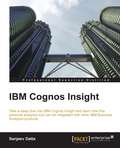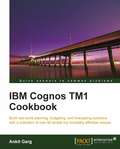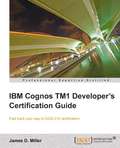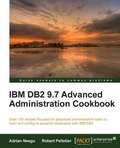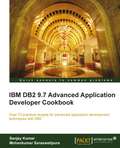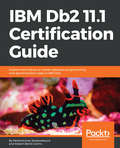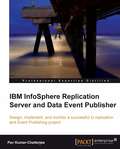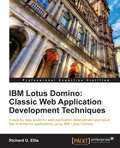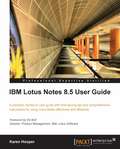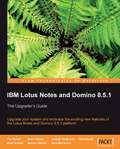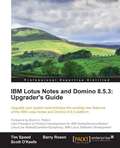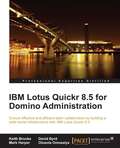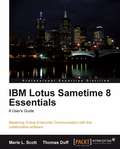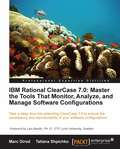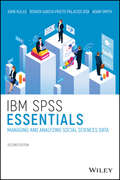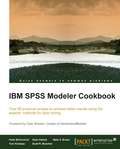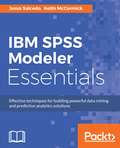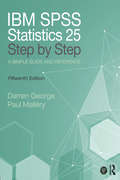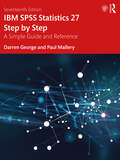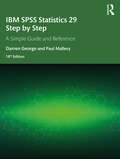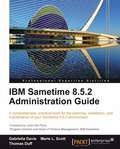- Table View
- List View
IBM Cognos Insight
by Sanjeev DattaThis book takes a practical tutorial approach to teaching users the features of Cognos Insight. New and existing users of Cognos Insight who are looking to gain more knowledge about the product and Business Analytics in general.
IBM Cognos TM1 Cookbook
by Ankit GargEach recipe comprises step-by-step instructions followed by an analysis of what was done in each task and other useful information. It is packed with useful screenshots to make your learning even easier. The book emphasizes on a learn-by-example approach so as to maximize learning. The book is intended for prospective TM1 developers or analysts who want to successfully build and manage a complete planning, budgeting and forecasting solution with IBM Cognos TM1. No previous knowledge of TM1 is expected. Existing TM1 users and developers will also benefit from the practical recipes covered in the book.
IBM Cognos TM1 Developer's Certification guide
by James D. MillerThis book is packed with real word examples. Each major certification topic is covered in a separate chapter, which helps to make understanding of concepts easier. At the end of each chapter, you will find a variety of practice questions to strengthen and test your learning. If you are a beginner to intermediate level Cognos TM1 developer looking to add an important IBM certification to your resume but don't know where to start, this book is for you!
IBM DB2 9.7 Advanced Administration Cookbook
by Robert Pelletier Adrian NeaguThis cookbook has recipes written in a simple, easy to understand format, with lots of screenshots and insightful tips and hints. If you are a DB2 Database Administrator who wants to understand and get hands on with the underlying aspects of database administration, then this book is for you. This book assumes that you have a basic understanding of DB2 database concepts.
IBM DB2 9.7 Advanced Application Developer Cookbook
by Sanjay Kumar Mohankumar SaraswatipuraThis cookbook has recipes written in a simple, easy to understand format with lots of screenshots and insightful tips and hints. If you are an IBM DB2 application developer who would like to exploit advanced features provided by DB2 to design and implement high quality applications, then this book is for you. This book assumes you have a basic understanding of the DB2 application development.
IBM Db2 11.1 Certification Guide: Explore techniques to master database programming and administration tasks in IBM Db2
by Robert Collins Mohankumar SaraswatipuraMastering material for dealing with DBA certification examsKey FeaturesPrepare yourself for the IBM C2090-600 certification examCover over 50 Db2 procedures including database design, performance, and securityWork through over 150 Q&As to gain confidence on each topicBook DescriptionIBM Db2 is a relational database managementsystem (RDBMS) that helps you store,analyze, and retrieve data efficiently. Thiscomprehensive book is designed to helpyou master all aspects of IBM Db2 databaseadministration and prepare you to take andpass IBM's Certification Exams C2090-600.Building on years of extensive experience,the authors take you through all areascovered by the test. The book delves deepinto each certification topic: Db2 servermanagement, physical design, businessrules implementation, activity monitoring,utilities, high availability, and security. IBMDb2 11.1 Certification Guide provides youwith more than 150 practice questionsand answers, simulating real certificationexamination questions. Each chapter includesan extensive set of practice questions alongwith carefully explained answers.This book will not just prepare youfor the C2090-600 exam but also helpyou troubleshoot day-to-day databaseadministration challenges.What you will learn Configure and manage Db2 servers, instances, and databases Implement Db2 BLU Acceleration and a DB2 pureScale environment Create, manage, and alter Db2 database objects Use the partitioning capabilities available within Db2 Enforce constraint checking with the SET INTEGRITY command Utilize the Db2 problem determination (db2pd) and dsmtop tools Configure and manage HADR Understand how to encrypt data in transit and at restWho this book is forThe IBM Db2 11.1 Certification Guide is an excellent choice for database administrators, architects, and application developers who are keen to obtain certification in Db2. Basic understanding of Db2 is expected in order to get the most out of this guide.
IBM InfoSphere Replication Server and Data Event Publisher
by Pav Kumar ChatterjeeThis is a developer's guide and is written in a style suitable to professionals. The initial chapters cover the basic theory and principles of Q replication and WebSphere MQ. As the book advances, numerous real-world scenarios and examples are covered with easy-to-understand code. The knowledge gained in these chapters culminate in the Appendix, which contains step-by-step instructions to set up various Q replication scenarios. If you are a professional who needs to set up and administer a Q replication or Event Publishing environment, then this is the book you need. The book will give you a clear idea of how to implement Q replication on z/OS whether you work on Linux, Unix, or Windows operating system.
IBM Lotus Domino: Classic Web Application Development Techniques
by Richard G. EllisChapters present principles and techniques in an order that roughly mirrors the application development process itself, from gathering requirements through final testing. The focus is on understanding and enhancing applications using classic techniques, in circumstances where it is impractical to rewrite applications using XPages. Each chapter focuses upon a particular aspect of Domino Web applications and provides guidance, recommendations, illustrations, and sample code.This book is for novice to moderately experienced Domino developers who are new to the task of Web-enabling traditional Domino applications. Readers should be familiar with using Domino Designer to develop applications for the Lotus Notes client. It is also assumed that readers have, or can acquire, at least rudimentary knowledge of HTML, CSS, and JavaScript.
IBM Lotus Notes 8.5 User Guide
by Karen HooperA compact Lotus Notes User Guide, this book covers best practices, hints, tips, and tricks of Lotus Notes 8.5. It draws on real-world examples and you will find this book to be an invaluable reference for Lotus Notes. There are significant changes from the earlier versions of Lotus Notes to the current version of 8.5 and this book covers the new features in detail so that you will be able to take advantage of them. However, this book also covers key features from earlier versions, which have stood the test of time. If you are a business user who wants to get the most out of Lotus Notes, then this book is for you. From beginners to seasoned professionals, this book aims to cover the features, best practices, tips, tricks, and tools that enable you to work smarter--almost effortlessly--in Lotus Notes 8.5.
IBM Lotus Notes 8.5 User Guide: LITE
by Karen HoopeA compact Lotus Notes User Guide, this book covers best practices, hints, tips, and tricks of Lotus Notes 8.5 Client Interface and Mail features. It draws on real-world examples and you will find this book to be an invaluable reference for Lotus Notes. The material has been carefully selected from Packt's fuller IBM Lotus Notes 8.5 User Guide. If you are a business user who wants to get the most out of Lotus Notes, then this book is for you. From beginners to seasoned professionals, this book aims to cover the Client Interface and Mail features, best practices, tips, tricks, and tools that enable you to work smarter--almost effortlessly--in Lotus Notes 8.5.
IBM Lotus Notes and Domino 8.5.1
by Bennie GibsonThis book walks through the new features of the Lotus Notes/Domino 8.5.1 suite and documents technical features in a descriptive way, with examples and useful screenshots. The book also discusses likely problems you might face while upgrading, and shows how to get the most out of the exciting new features. This book is for Lotus Notes power users, administrators, and developers working with any version of Lotus Notes/Domino, who want to upgrade to Lotus Notes/Domino 8.5.1. Additionally, it can be leveraged by management to gain a high-level understanding of the new features and capabilities offered within the products.
IBM Lotus Notes and Domino 8.5.3: Upgrader's Guide
by Barry Rosen Tim Speed Scott O KeefeThis practical tutorial walks through the new features of the Lotus Notes/Domino 8.5.3 suite and documents technical features in a descriptive way, with examples and useful screenshots. The book also discusses likely problems you might face while upgrading, and shows you how to get the most out of the exciting new features. This book is for Lotus Notes power users, administrators, and developers working with any version of Lotus Notes/Domino, who want to upgrade to Lotus Notes/Domino 8.5.3. Additionally, it can be leveraged by management to gain a high-level understanding of the new features and capabilities offered within the products.
IBM Lotus Quickr 8.5 for Domino Administration
by Keith Brooks David ByrdThis is a step-by-step manual, with explanation from installation and upgrading, to the development and management of Quickr, to what-to-do-next when you finally have everything set up. It discusses problems that you might face while upgrading to the latest version. The authors show you how to get the most out of the most important features including installing, configuring, maintaining, and troubleshooting a clustered environment with Lotus Quickr.This is a step-by-step manual for System Administrators and Business Analysts who need to facilitate the effective and efficient performance of diverse teams in an interconnected world. It can also be read by Management to gain a high-level understanding of the new features and capabilities offered by the product. You don't require any knowledge of IBM Lotus Quickr 8.5. This book will teach you everything you need to know.
IBM Lotus Sametime 8 Essentials: A User's Guide
by Marie Scott Thomas DuffAs a user, you will learn, using real-world scenarios and tasks, exactly how to use all the features of Sametime. Beginning with how to install Sametime, we've included step-by-step descriptions and screen prints for each topic area in a clear easy-to-follow format. Each chapter builds on what you learn in earlier chapters and guides you into using the more advanced features of Sametime, but if you only want to develop your skills in one particular area, each chapter acts as a stand-alone module. If you want to learn how to use IBM Lotus Sametime, then this book is for you. No matter if you're new to Sametime or want to become a Sametime power user, this book contains something for you. The focus is on using Sametime as a user and does not include information about development or administration of a Sametime environment; but any user of Sametime in an organization will be able to take this book, sit down at their computer, and learn how to use each feature of Sametime from start to finish.
IBM Rational ClearCase 7.0: Master the Tools That Monitor, Analyze, and Manage Software Configurations
by Marc Girod Tatiana ShpichkoThis is a practical book with plenty of code examples for mastering ClearCase tools to monitor, analyze, and manage software configurations.If you are a developer who wants to use ClearCase for software development then this book is for you. This book is not for experts, but it will certainly challenge your technical skills.While ClearCase concepts and tools are presented for those unfamiliar with the tool, an ability to use the command line as well as some fluency with shell scripting will certainly be an advantage.
IBM Rational Team Concert 2 Essentials
by Suresh Krishna Tc FenstermakerWith their straightforward style, Suresh Krishna and TC Fenstermaker have put their years of experience and motivation into this practical guide that assists in finding an integrated approach to increased team productivity. The numerous tips, notes, and suggestions strengthen your grasp of fundamentals and the foundation upon which you are ready to build your customized Rational Team Concert application. Ample screenshots make sure that you get the configurations correct the first time. A real-world Book Manager Application walks you through all the core features of the Rational Team Concert during different phases of development and release.If you are a Project Manager or a Team Member, who would like to find an integrated approach to deal with modern software development challenges, you should read this book. Or if you are someone who likes to stay one step ahead in team management, you have got the right choice here.
IBM SPSS Essentials: Managing and Analyzing Social Sciences Data
by Adam M. Smith John T. Kulas Renata Garcia Prieto Palacios RojiMaster the fundamentals of SPSS with this newly updated and instructive resource The newly and thoroughly revised Second Edition of SPSS Essentials delivers a comprehensive guide for students in the social sciences who wish to learn how to use the Statistical Package for the Social Sciences (SPSS) for the effective collection, management, and analysis of data. The accomplished researchers and authors provide readers with the practical nuts and bolts of SPSS usage and data entry, with a particular emphasis on managing and manipulating data. The book offers an introduction to SPSS, how to navigate it, and a discussion of how to understand the data the reader is working with. It also covers inferential statistics, including topics like hypothesis testing, one-sample Z-testing, T-testing, ANOVAs, correlations, and regression. Five unique appendices round out the text, providing readers with discussions of dealing with real-world data, troubleshooting, advanced data manipulations, and new workbook activities. SPSS Essentials offers a wide variety of features, including: A revised chapter order, designed to match the pacing and content of typical undergraduate statistics classes An explanation of when particular inferential statistics are appropriate for use, given the nature of the data being worked with Additional material on understanding your data sample, including discussions of SPSS output and how to find the most relevant information A companion website offering additional problem sets, complete with answers Perfect for undergraduate students of the social sciences who are just getting started with SPSS, SPSS Essentials also belongs on the bookshelves of advanced placement high school students and practitioners in social science who want to brush up on the fundamentals of this powerful and flexible software package.
IBM SPSS Modeler Cookbook
by Scott R. Mutchler Keith Mccormick Meta S. Brown Dean Abbott Tom KhabazaThis is a practical cookbook with intermediate-advanced recipes for SPSS Modeler data analysts. It is loaded with step-by-step examples explaining the process followed by the experts.If you have had some hands-on experience with IBM SPSS Modeler and now want to go deeper and take more control over your data mining process, this is the guide for you. It is ideal for practitioners who want to break into advanced analytics.
IBM SPSS Modeler Essentials: Effective techniques for building powerful data mining and predictive analytics solutions
by Keith McCormick Jose Jesus Salcedo Bowen WeiKey Features Get up–and-running with IBM SPSS Modeler without going into too much depth. Identify interesting relationships within your data and build effective data mining and predictive analytics solutions A quick, easy–to-follow guide to give you a fundamental understanding of SPSS Modeler, written by the best in the business Book Description IBM SPSS Modeler allows users to quickly and efficiently use predictive analytics and gain insights from your data. With almost 25 years of history, Modeler is the most established and comprehensive Data Mining workbench available. Since it is popular in corporate settings, widely available in university settings, and highly compatible with all the latest technologies, it is the perfect way to start your Data Science and Machine Learning journey. This book takes a detailed, step-by-step approach to introducing data mining using the de facto standard process, CRISP-DM, and Modeler’s easy to learn “visual programming” style. You will learn how to read data into Modeler, assess data quality, prepare your data for modeling, find interesting patterns and relationships within your data, and export your predictions. Using a single case study throughout, this intentionally short and focused book sticks to the essentials. The authors have drawn upon their decades of teaching thousands of new users, to choose those aspects of Modeler that you should learn first, so that you get off to a good start using proven best practices. This book provides an overview of various popular data modeling techniques and presents a detailed case study of how to use CHAID, a decision tree model. Assessing a model’s performance is as important as building it; this book will also show you how to do that. Finally, you will see how you can score new data and export your predictions. By the end of this book, you will have a firm understanding of the basics of data mining and how to effectively use Modeler to build predictive models. What you will learn Understand the basics of data mining and familiarize yourself with Modeler’s visual programming interface Import data into Modeler and learn how to properly declare metadata Obtain summary statistics and audit the quality of your data Prepare data for modeling by selecting and sorting cases, identifying and removing duplicates, combining data files, and modifying and creating fields Assess simple relationships using various statistical and graphing techniques Get an overview of the different types of models available in Modeler Build a decision tree model and assess its results Score new data and export predictions
IBM SPSS Statistics 23 Step by Step: A Simple Guide and Reference (14th Edition)
by Darren George Paul MalleryIBM SPSS Statistics 23 Step by Step: A Simple Guide and Reference, 14e, takes a straightforward, step-by-step approach that makes SPSS software clear to beginners and experienced researchers alike. Extensive use of vivid, four-color screen shots, clear writing, and step-by-step boxes guide readers through the program. Exercises at the end of each chapter support students by providing additional opportunities to practice using SPSS. All datasets used in the book are available for download at: https://www.routledge.com/products/ 9780134320250
IBM SPSS Statistics 25 Step by Step: A Simple Guide and Reference
by Darren George Paul MalleryIBM SPSS Statistics 25 Step by Step: A Simple Guide and Reference, fifteenth edition, takes a straightforward, step-by-step approach that makes SPSS software clear to beginners and experienced researchers alike. Extensive use of four-color screen shots, clear writing, and step-by-step boxes guide readers through the program. Exercises at the end of each chapter support students by providing additional opportunities to practice using SPSS. This book covers both the basics of descriptive statistical analysis using SPSS through to more advanced topics such as multiple regression, multidimensional scaling and MANOVA, including instructions for Windows and Mac. This makes it ideal for both undergraduate statistics courses and for postgraduates looking to further develop their statistics and SPSS knowledge. New to this edition: Updated throughout to SPSS 25 Updated / restructured material on: Chart Builder; Univariate ANOVA; moderation on two- and three-way ANOVA; and Factor Analytic Techniques (formerly Factor Analysis structure) New material on computing z and T scores, and on computing z scores within descriptive statistics Clearer in-chapter links between the type of data and type of research question that the procedure can answer Updated / additional datasets, exercises, and expanded Companion Website material, including Powerpoint slides for instructors
IBM SPSS Statistics 26 Step by Step: A Simple Guide and Reference
by Darren George Paul MalleryIBM SPSS Statistics 26 Step by Step: A Simple Guide and Reference, sixteenth edition, takes a straightforward, step-by-step approach that makes SPSS software clear to beginners and experienced researchers alike. Extensive use of four-color screen shots, clear writing, and step-by-step boxes guide readers through the program. Output for each procedure is explained and illustrated, and every output term is defined. Exercises at the end of each chapter support students by providing additional opportunities to practice using SPSS. This book covers the basics of statistical analysis and addresses more advanced topics such as multi-dimensional scaling, factor analysis, discriminant analysis, measures of internal consistency, MANOVA (between- and within-subjects), cluster analysis, Log-linear models, logistic regression and a chapter describing residuals. Back matter includes a description of data files used in exercises, an exhaustive glossary, suggestions for further reading and a comprehensive index. IMB SPSS Statistics 26 Step by Step is distributed in 85 countries, has been an academic best seller through most of the earlier editions, and has proved invaluable aid to thousands of researchers and students. New to this edition: Screenshots, explanations, and step-by-step boxes have been fully updated to reflect SPSS 26 How to handle missing data has been revised and expanded and now includes a detailed explanation of how to create regression equations to replace missing data More explicit coverage of how to report APA style statistics; this primarily shows up in the Output sections of Chapters 6 through 16, though changes have been made throughout the text.
IBM SPSS Statistics 27 Step by Step: A Simple Guide and Reference
by Darren George Paul MalleryIBM SPSS Statistics 27 Step by Step: A Simple Guide and Reference, seventeenth edition, takes a straightforward, step-by-step approach that makes SPSS software clear to beginners and experienced researchers alike. Extensive use of four-color screen shots, clear writing, and step-by-step boxes guide readers through the program. Output for each procedure is explained and illustrated, and every output term is defined. Exercises at the end of each chapter support students by providing additional opportunities to practice using SPSS. This book covers the basics of statistical analysis and addresses more advanced topics such as multidimensional scaling, factor analysis, discriminant analysis, measures of internal consistency, MANOVA (between- and within-subjects), cluster analysis, Log-linear models, logistic regression, and a chapter describing residuals. The end sections include a description of data files used in exercises, an exhaustive glossary, suggestions for further reading, and a comprehensive index. IBM SPSS Statistics 27 Step by Step is distributed in 85 countries, has been an academic best seller through most of the earlier editions, and has proved an invaluable aid to thousands of researchers and students. New to this edition: Screenshots, explanations, and step-by-step boxes have been fully updated to reflect SPSS 27 A new chapter on a priori power analysis helps researchers determine the sample size needed for their research before starting data collection.
IBM SPSS Statistics 29 Step by Step: A Simple Guide and Reference
by Darren George Paul MalleryIBM SPSS Statistics 29 Step by Step: A Simple Guide and Reference, eighteenth edition, takes a straightforward, step-by-step approach that makes SPSS software clear to beginners and experienced researchers alike.Extensive use of four-color screen shots, clear writing, and step-by-step boxes guide readers through the program. Output for each procedure is explained and illustrated, and every output term is defined. Exercises at the end of each chapter support students by providing additional opportunities to practice using SPSS. This book covers the basics of statistical analysis and addresses more advanced topics such as multidimensional scaling, factor analysis, discriminant analysis, measures of internal consistency, MANOVA (between- and within-subjects), cluster analysis, Log-linear models, logistic regression, and a chapter describing residuals. New to this edition is a new chapter on meta-analysis that describes new SPSS procedures for analyzing effect sizes across studies, and the content has been thoroughly updated in line with the latest version of the SPSS software, SPSS 29. The end sections include a description of data files used in exercises, an exhaustive glossary, suggestions for further reading, and a comprehensive index.Accompanied by updated online instructor’s materials and website data files, this is an essential resource for instructors and students needing a guide to using SPSS in their work, across the social sciences, behavioural sciences, education, and beyond.
IBM Sametime 8.5.2 Administration Guide
by Marie L. Scott Gabriella DavisThe IBM Lotus Sametime 8.5.2 Administration Guide uses a practical, no-nonsense approach to give you the essential information you need. Using realistic scenarios, you learn how to configure and maintain your environment to meet your needs and take advantage of the flexibility offered in Sametime 8.5.2. If you are responsible for installing and administering Sametime 8.5.2, then this book is for you. If you're completely new to Sametime administration, this book will serve as your roadmap. If you're making the jump from a prior version of Sametime, then you'll see how Sametime 8.5.2 differs and how you work with the new configuration. Even if you already have Sametime 8.5.2 up and running, this guide will answer those questions you may still have of why and how the various server components work.
